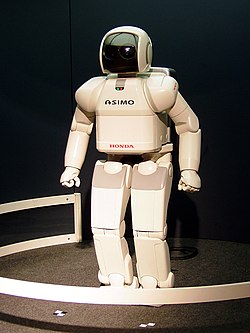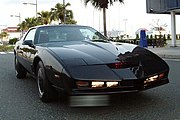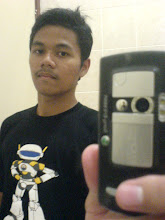
Saturday, July 25, 2009
Robots

Robot is a virtual or mechanical artificial agent. In practice, it is usually an electro-mechanical system which, by its appearance or movements, conveys a sense that it has intent or agency of its own. The word robot can refer to both physical robots and virtual software agents, but the latter are usually referred to as bots.There is no consensus on which machines qualify as robots, but there is general agreement among experts and the public that robots tend to do some or all of the following: move around, operate a mechanical limb, sense and manipulate their environment, and exhibit intelligent behavior, especially behavior which mimics humans or other animals. In South Africa, robot is an informal and commonly used term for a set of traffic lights.
Stories of artificial helpers and companions and attempts to create them have a long history but fully autonomous machines only appeared in the 20th century. The first digitally operated and programmable robot, the Unimate, was installed in 1961 to lift hot pieces of metal from a die casting machine and stack them. Today, commercial and industrial robots are in widespread use performing jobs more cheaply or with greater accuracy and reliability than humans. They are also employed for jobs which are too dirty, dangerous or dull to be suitable for humans. Robots are widely used in manufacturing, assembly and packing, transport, earth and space exploration, surgery, weaponry, laboratory research, and mass production of consumer and industrial goods.
Modern robots are usually used in tightly controlled environments such as on assembly lines because they have difficulty responding to unexpected interference. Because of this, most humans rarely encounter robots. However, domestic robots for cleaning and maintenance are increasingly common in and around homes in developed countries, particularly in Japan. Robots can also be found in the military.
Defining characteristics
 |  | |
| KITT is mentally anthropomorphic, while ASIMO is physically anthropomorphic | ||
While there is no single correct definition of "robot",a typical robot will have several or possibly all of the following characteristics.
- It is composed entirely, or almost entirely, from artificial substances.
- It can sense its environment, and manipulate or interact with things in it.
- It has some ability to make choices based on the environment, often using automatic control or a preprogrammed sequence.
- It is programmable.
- It moves with one or more axes of rotation or translation.
- It makes dexterous coordinated movements.
- It moves without direct human intervention.
- It appears to have intent or agency.
The last property, the appearance of agency, is important when people are considering whether to call a machine a robot, or just a machine. (See anthropomorphism for examples of ascribing intent to inanimate objects.)
Mental agency
For robotic engineers, the physical appearance of a machine is less important than the way its actions are controlled. The more the control system seems to have agency of its own, the more likely the machine is to be called a robot. An important feature of agency is the ability to make choices.
- A clockwork car is never considered a robot.
- A remotely operated vehicle is sometimes considered a robot (or telerobot).
- A car with an onboard computer, like Bigtrak, which could drive in a programmable sequence, might be called a robot.
- A self-controlled car which could sense its environment and make driving decisions based on this information, such as the 1990s driverless cars of Ernst Dickmanns or the entries in the DARPA Grand Challenge, would quite likely be called a robot.
- A sentient car, like the fictional KITT, which can make decisions, navigate freely and converse fluently with a human, is usually considered a robot.
Physical agency
However, for many laymen, if a machine appears to be able to control its arms or limbs, and especially if it appears anthropomorphic or zoomorphic (e.g. ASIMO or Aibo), it would be called a robot.
- A player piano is rarely characterized as a robot.
- A CNC milling machine is very occasionally characterized as a robot.
- A factory automation arm is almost always characterized as an industrial robot.
- An autonomous wheeled or tracked device, such as a self-guided rover or self-guided vehicle, is almost always characterized as a mobile robot or service robot.
- A zoomorphic mechanical toy, like Roboraptor, is usually characterized as a robot.
- A mechanical humanoid, like ASIMO, is almost always characterized as a robot, usually as a service robot.
Even for a 3-axis CNC milling machine using the same control system as a robot arm, it is the arm which is almost always called a robot, while the CNC machine is usually just a machine. Having eyes can also make a difference in whether a machine is called a robot, since humans instinctively connect eyes with sentience. However, simply being anthropomorphic is not a sufficient criterion for something to be called a robot. A robot must do something; an inanimate object shaped like ASIMO would not be considered a robot.
Definitions
It is difficult to compare numbers of robots in different countries, since there are different definitions of what a "robot" is. The International Organization for Standardization gives a definition of robot in ISO 8373: "an automatically controlled, reprogrammable, multipurpose, manipulator programmable in three or more axes, which may be either fixed in place or mobile for use in industrial automation applications."This definition is used by the International Federation of Robotics, the European Robotics Research Network (EURON), and many national standards committees.
The Robotics Institute of America (RIA) uses a broader definition: a robot is a "re-programmable multi-functional manipulator designed to move materials, parts, tools, or specialized devices through variable programmed motions for the performance of a variety of tasks".The RIA subdivides robots into four classes: devices that manipulate objects with manual control, automated devices that manipulate objects with predetermined cycles, programmable and servo-controlled robots with continuous point-to-point trajectories, and robots of this last type which also acquire information from the environment and move intelligently in response.
There is no one definition of robot which satisfies everyone, and many people have their own.For example, Joseph Engelberger, a pioneer in industrial robotics, once remarked: "I can't define a robot, but I know one when I see one."According to Encyclopaedia Britannica, a robot is "any automatically operated machine that replaces human effort, though it may not resemble human beings in appearance or perform functions in a humanlike manner".[12] Merriam-Webster describes a robot as a "machine that looks like a human being and performs various complex acts (as walking or talking) of a human being", or a "device that automatically performs complicated often repetitive tasks", or a "mechanism guided by automatic controls".
Etymology
The word robot was introduced to the public by Czech writer Karel Čapek in his play R.U.R. (Rossum's Universal Robots), published in 1920.The play begins in a factory that makes artificial people called robots, but they are closer to the modern ideas of androids, creatures who can be mistaken for humans. They can plainly think for themselves, though they seem happy to serve. At issue is whether the robots are being exploited and the consequences of their treatment.
However, Karel Čapek himself did not coin the word. He wrote a short letter in reference to an etymology in the Oxford English Dictionary in which he named his brother, the painter and writer Josef Čapek, as its actual originator.In an article in the Czech journal Lidové noviny in 1933, he explained that he had originally wanted to call the creatures laboři (from Latin labor, work). However, he did not like the word, and sought advice from his brother Josef, who suggested "roboti". The word robota means literally work, labor or serf labor, and figuratively "drudgery" or "hard work" in Czech and many Slavic languages.Serfdom was outlawed in 1848 in Bohemia, so at the time Čapek wrote R.U.R., usage of the term robota had broadened to include various types of work, but the obsolete sense of "serfdom" would still have been known.
The word robotics, used to describe this field of study, was coined (albeit accidentally) by the science fiction writer Isaac Asimov.


